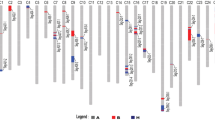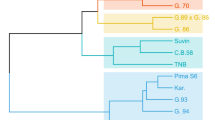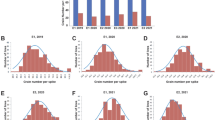Abstract
Investigation of cotton nutritional components is important because its seeds provide a useful nutritional profile and can possibly serve as a biofuel resource. In this study, five cultivars, 13 cotton chromosome substitution (CS-B) lines, their donor parent, '3-79', and their recurrent parent, 'TM-1', were evaluated for seed traits over four environments. A mixed linear model approach with the jackknife method was employed to estimate variance components and to predict genotypic effects for each seed trait. Genotypic effects were more important than genotype by environment interaction for all seed traits. Chromosome associations with these seed traits were detected using the comparative method by comparing the differences between each CS-B line and TM-1. For example, chromosome 4 of 3-79 in TM-1 background was associated with reduced seed index (SI), embryo percentage, protein percentage while associated with increased seed oil percentage and seed fiber percentage. Other chromosome associations with these seed traits were also observed in this study. SI was highly correlated with three seed index traits: seed protein index, seed oil index (OI), and seed fiber index. Lint percentage, boll number, and lint yield were positively correlated with protein percentage while negatively correlated with SI and OI. SI and seed fiber content exhibited negative correlations with micronaire but positive correlations with fiber length and strength. Results suggested that agronomic traits and seed nutrition components can be improved simultaneously.
Similar content being viewed by others
Abbreviations
- CS-B:
-
Chromosome substitution line from G. barbadense
- SI:
-
Seed index
- EP:
-
Seed embryo percentage
- PP:
-
Seed protein percentage
- OP:
-
Seed oil percentage
- FP:
-
Seed fiber percentage
- PI:
-
Seed protein index
- OI:
-
Seed oil index
- FI:
-
Seed fiber index
References
Allen CAW, Watts KC (2000) Comparative analysis of the atomization characteristics of fifteen biodiesel fuel types. Am Soc Agric Eng 43:207–211
Barros MM, Lim C, Evans JJ, Klesius PH (2000) Effects of iron supplementation to cottonseed meals diets on the growth performance of channel catfish, Ictalurus punctatus. J App Aquat 10:65–86. doi:10.1300/J028v10n01_07
Belyea RL, Steevens BJ, Restrepo RJ, Clubb AP (1989) Variation in composition of by-product feeds. J Dairy Sci 72:2339–2345
Blasi DA, Drouillard J (2002) Composition and feeding value of cottonseed feed products for beef cattle. Kansas State Univ Agri Exp Stn & Coop Ext Serv contribution no. 02-426-E
Bourland FM, Bird LS (1983) Genetic evaluation of selected seed and seed-coat traits in cotton. J Hered 74:118–120
Cherry JP (1983) Cottonseed oil. J Am Oil Chem Soc 60:360–367. doi:10.1007/BF02543519
Cherry JP, Simmons JG, Kohel RJ (1978a) Potential for improving cottonseed quality by genetics and agronomic practices. In: Friedman M (ed) Nutritional improvement of food and feed proteins. Plenum Press, New York, pp 343–364
Cherry JP, Simmons JG, Kohel RJ (1978b) Cottonseed composition of national variety test cultivars grown at different Texas locations. In: Brown JM (ed) Proceedings of the Beltwide cotton production research conference, Dallas, TX. National Cotton Council, Memphis, pp 47–50
Cunniff P (1995) Association of analytical chemists: official methods of analysis of AOAC International. AOAC International, Arlington
Dani RG, Kohel RJ (1988) Maternal effects and generation mean analysis of seed-oil content in cotton (Gossypium hirsutum L.). Theor Appl Genet 77:569–575
Endrezzi JE (1963) Genetic analysis of six primary monosomes and one tertiary monosome in Gossypium hirsutum. Genetics 48:1625–1633
Jenkins JN, Wu J, McCarty JC, Saha S, Gutierrez O, Hayes R, Stelly DM (2006) Genetic evaluation for thirteen chromosome substitution lines crossed with five commercial cultivars: I. yield traits. Crop Sci 46:1169–1178. doi:10.2135/cropsci2005.08-0269
Jenkins JN, McCarty JC, Wu J, Saha S, Gutierrez O, Hayes R, Stelly DM (2007) Genetic evaluation of thirteen chromosome substitution lines crossed with five commercial cultivars: II. Fiber quality traits. Crop Sci 47:561–572
Karaosmanoglu F, Tuter M, Gollu E, Yanmaz S, Altintig E (1999) Fuel properties of cottonseed oil. Energy Sources 21:821–828. doi:10.1080/00908319950014371
Kohel RJ, Richmond TR, Lewis CF (1970) Texas marker-1: description of a genetic standard for Gossypium hirsutum L. Crop Sci 10:670–671
Kohel RJ, Endrizzi JE, White TG (1977) An evaluation of Gossypium barbadense L. chromosome 6 and 17 in the G. hirsutum L. genome. Crop Sci 17:404–406
Kohel RJ, Glueck J, Rooney LW (1985) Comparison of cotton germplasm collections for seed-protein content. Crop Sci 25:961–963
Liu Q, Singh S, Green A (2002) High-oleic and high-stearic cottonseed oils: nutritionally improved cooking oils developed using gene silencing. J Am Coll Nutr 21:205–211
Ma JZ, Kohel RJ (1983) Evaluation of 6 substitution lines in cotton. Acta Agronom Sin 9:145–150
McCarty JC, Wu J, Saha S, Jenkins JN, Hayes R (2006) Effects of chromosome 5sh from Gossypium barbadense L. on flower production in G. hirsutum L. Euphytica 152:99–107. doi:10.1007/s10681-006-9183-7
Meneghetti SMP, Meneghetti MR, Serra TM, Barbosa DC, Wolf CR (2007) Biodiesel production from vegetable oil mixtures: cottonseed, soybean, and castor oils. Energy Fuels 21:3746–3747. doi:10.1021/ef070039q
Miller RG (1974) The jackknife: a review. Biometrika 61:1–15
Saha S, Wu J, Jenkins JN, McCarty JC, Gutiérrez O, Stelly DM, Percy RG, Raska DA (2004) Effect of chromosome substitutions from Gossypium barbadense L. 3-79 into G. hirsutum L. TM-1 on agronomic and fiber traits. J Cotton Sci 8:162–169
Saha S, Jenkins JN, Wu J, McCarty JC, Gutierrez O, Percy RC, Cantrell RG, Stelly DM (2006) Effects of chromosome specific introgression in upland cotton on fiber and agronomic traits. Genetics 172:1927–1938. doi:10.1534/genetics.105.053371
SAS Institute Inc (2003) SAS software version 9.0. SAS Institute, Cary
Stelly DM, Saha A, Raska DA, Jenkins JN, McCarty JC, Gutierrez OA (2005) Registration of 17 germplasm lines of upland cotton (Gossypium hirsutum), each with a different pair of G. barbadense chromosome or chromosome arms substituted for the respective G. hirsutum chromosome or chromosome arms. Crop Sci 45:2663–2665. doi:10.2135/cropsci2004.0642
Tang B, Jenkins JN, Watson CE, McCarty JC, Creech RG (1996) Evaluation of genetic variances, heritabilities, and correlations for yield and fiber traits among cotton F2 hybrid populations. Euphytica 91:315–322. doi:10.1007/BF00033093
Turner JH, Ramey HH, Worley S (1976) Influence of environment on seed quality of four cotton cultivars. Crop Sci 16:407–409
Wang G, Zhu J, Zang R, Xu F, Ji D (1996a) Analysis of covariance components between seed and agronomy traits in upland cotton. Acta Gossypii Sin 8(6):295–300
Wang G, Zhu J, Zang R, Xu F, Ji D (1996b) Analysis of genetic correlation among seed nutrient quality traits and seed physical traits in upland cotton. J Zhejiang Agric Univ 22:585–590
Wu J, Zhu J, Ji D, Xu F (1995) Genetic analysis of direct and maternal effects of seed traits in upland cotton (Chinese). Acta Agronom Sin 21(6):659–664
Wu J, Jenkins JN, McCarty JC, Saha S, Stelly DM (2006) An additive-dominance model to determine chromosomal effects in chromosome substitution lines and other germplasms. Theor Appl Genet 112:391–399. doi:10.1007/s00122-005-0042-z
Ye Z, Lu Z, Zhu J (2003) Genetic analysis for developmental behavior of some seed quality traits in Upland cotton (Gossypum hirsutum L.). Euphytica 129:183–191. doi:10.1023/A:1021974901501
Zhu J (1989) Estimation of genetic variance components in the general mixed model. Ph.D. Dissertation, North Carolina State University, Raleigh (Diss. Abstr. DA8924291)
Zhu J (1993) Methods of predicting genotype value and heterosis for offspring of hybrids (Chinese). J Biomath 8(1):32–44
Acknowledgments
This study was supported by Mississippi Agricultural and Forestry Experiment Station (Project No. 900100).
Disclaimer
Contribution of the USDA-ARS in cooperation with Mississippi Agri. and Forestry Exp. Stn. Mention of trademark, proprietary product, or vendor does not imply its approval to exclusion of other products or vendors that may also be suitable.
Author information
Authors and Affiliations
Corresponding authors
Rights and permissions
About this article
Cite this article
Wu, J., Jenkins, J.N., McCarty, J.C. et al. Seed trait evaluation of Gossypium barbadense L. chromosomes/arms in a G. hirsutum L. background. Euphytica 167, 371–380 (2009). https://doi.org/10.1007/s10681-009-9896-5
Received:
Accepted:
Published:
Issue Date:
DOI: https://doi.org/10.1007/s10681-009-9896-5




